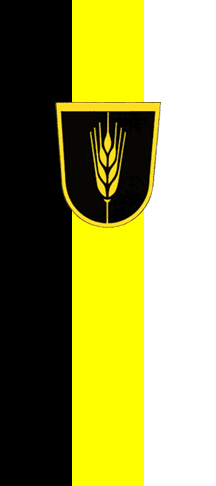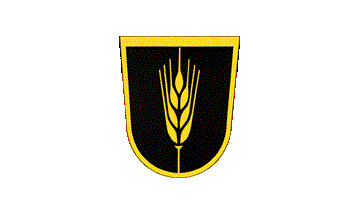 9:4 Image by Jens Pattke, 9 April 2014
9:4 Image by Jens Pattke, 9 April 2014
Last modified: 2020-07-26 by pete loeser
Keywords: territorial association of the russian germans | landsmannschaft der russlanddeutschen e.v. | russian germans | russlanddeutschen | vertriebene | refugees | coat of arms (wheat ear) |
Links: FOTW homepage |
search |
disclaimer and copyright |
write us |
mirrors
 9:4 Image by Jens Pattke, 9 April 2014
9:4 Image by Jens Pattke, 9 April 2014
Jens Pattke reported in the German vexillology mailing list about the flag of one of the Landsmannschaften (territorial or country associations) of Vertriebene (refugees from former German territories or formerly German-inhabited regions in Eastern Europe). He explained that the Russian Germans held their congress on 2nd June 2001 in Stuttgart. A black-white-yellow hanging flag with coat-of-arms could be seen on TV reports hanging above the congress' chair.
Santiago Dotor, 8 June 2001
The Territorial Association of Germans from Russia (LMDR) is an organization that represents the interests of Germans who were expelled from countries of the former Soviet Union, such as Altay, Kazakhstan, Uzbekistan, and Turkmenistan, and immigrated back to Germany in the decades following the Second World War.
The Territorial Association was founded in August of 1955. It replaced the Arbeitsgruppe der Ost-Umsiedler (Club of the Eastern Ethnic Resettlers) whose membership first consisted of Russian emigrants living in Western Europe in exile. (Former Russian nobility, anti-communists, monarchists, former prisoners of the Russian "Vlasov" Army, Tatars and Caucasians, who served in the Wehrmacht, and fell into Western Allied hands).
The mid-1970s saw the first Volga German exiles from the Soviet Union arrive in numbers in both the Federal Republic of Germany and in the German Democratic Republic. With this increased presence the Territorial Association of Germans from Russia was turned into a political homeland association. In the 1990s, this organization expanded its goals. It supported the efforts of the Germans from Russia (and Kazakhstan, Uzbekistan, Turkmenistan), to integrate into German society. These settlers had great pride in their German ethnic origins, but they also valued their Russian traditions. Later many Russian Jews who immigrated to Germany also found a new home in the Territorial Association, joining not for religious reasons, but from longing for their old country in the former Soviet Union.
In the early 1970s, the Association unofficially would use a plain white flag with their coat of arms. The coat of arms had been adopted in the 1950s. It showed a golden ear of corn on a black background and symbolizes the Chernozem (Black Dirt) of the old country in the Volga Territory. In the 1990s a flag with a stripe pattern of black-white-yellow was adopted and the coat of arms placed in the center.
In 2002 the latest flag version was adopted. The flag's stripes were reorganized in the color sequence of the Russian Empire (black-yellow-white). The colors were reminiscent of the Empress Catherine II (Catherine the Great), who came from Germany. She encouraged many Germans to settle in the fertile region on the Volga River. This territory included Kazakhstan, Uzbekistan, and Turkmenistan, which later became part of the Soviet Union.
References: Flaggenkurier Nr. 22, Landsmannschaft der Deutschen aus Russland e.V. (photo), Union der Vertriebenen-Landesverband Hessen (photo), and Landsmannschaft der Deutschen aus Rusland, Landesgruppe NRW (photo).
Jens Pattke, 9 April 2014
 Speculative Image by Pete Loeser
Speculative Image by Pete Loeser
There was no official flag between 1955-c1995. Provisionally the LMDR used a flag, which was a white cloth. In the center of the cloth, the coat of arms was arranged.
Jens Pattke, 9 April 2014
The former colors of the Territorial Association flag was black-white-yellow. The organization's coat-of-arms was placed in the center. The coat-of-arms shows a golden ear of corn on a black background. Black symbolized the black earth, white the peace and yellow the richness of the agricultural work. This flag was adopted c1995
References: Landsmannschaft der Deutschen aus Russland e.V. (photo), and Wikipedia Die freie Enzyklopädie.
Jens Pattke, 9 April 2014
 Image by Jens Pattke, 9 April 2014
Image by Jens Pattke, 9 April 2014
Decorative composition flag of the Volga Germans ethnic group; not officially in use.
The Volga Germans (Wolgadeutsche) were Germans living along the Volga River in Russia. As immigrants to Russia in the 18th century they kept their culture, language, traditions, and Lutheran and Catholic churches. Many Volga Germans later emigrated to the North and South Dakota and other western states as far south as Kansas to escape persecution. Others immigrated to Canada, Argentina, Paraguay, and Brazil. During World War II, the Soviet government considered the Volga Germans undesirables and sent them to work camps in Siberia and other points east to die. After the war years, many of the remaining Volga Germans moved from the Soviet Union back to Germany.
This flag is presented as the national flag of the living descendants of Volga Germans living in Russia and Middle Asia. According to this website: "The flag of the Volga Germans is a more recent creation It has nothing to do with the flag of the former Soviet Republic of the Volga Germans. It shows the colours of Germany, three horizontal stripes in black, red and gold, and in the center a golden bordered black scutcheon with a golden wheat in the middle. The flag embodies the German nationality, and the rural working and living way, followed by the majority of the Volga Germans."
Sources: Flag glossary (Flaggenlexikon).
Pete Loeser, 7 April 2014
This modern variant flag with the coat-of-arms of the Territorial Association and the German colors, black-red-gold, is actually a decorative composition, but some local groups of the Territorial Association are now using it as a flag. It is not an official flag of the Landsmannschaft der Deutschen von Russland (Territorial Association of the Germans from Russia).
Jens Pattke, 9 April 2014